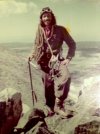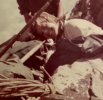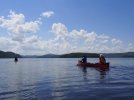This is also posted in the "SDFK is glorious" thread.
I went camping with my wife this weekend to get away from the city hustle and bustle, along with the acvompanying noise. It was an unplanned last minute trip, which made options for camping spots limited.
I took my Signature SDFK (SSDFK) along for the ride and decided to use it for whatever tasks popped up along the way.
We knew the area we decided on going would have plenty of dry wood from dead-fall and loose limbs. Enter the SSDFK.
In the photo below you can see a 12 to 15 foot branch from a dead tree. It was approximately 6 and 1/2 inches in diameter. I purposely made processing the wood as hard on the knife as possible. I wanted to test the legendary toughness of CPK'S delta 3V for myself.
First, I chopped through the fork in the branch using the SSDFK in a three finger grip. Woodchips flew like confetti at a New Year's party. No problem. The limb was separated with ease.
Next, I began to baton the knife through logs I sawed off using a silky. I deliberately split directly through the hard heartwood and even a couple knots.
You can see that the knife blade was deeply embedded in one of the logs in the picture below.
I hammered the spine of the knife savagely, as hard as I could, to get it to split the log. Then when the SSDFK was so deep in the wood that I couldn't hit the spine any longer, I pummeled the exposed front portion of the blade, showing no mercy or concern for the tip. As I smashed the hard log, chosen as my mallet, into the knife over and over again, I thought I saw the edge of the spine begin to glint and roll slightly. This didn't change the force I used, but my confidence wavered ever so slightly.
At one point the knife was wedged so tightly and deeply I couldn't baton it further into the log. So I raised the knife with the log attached, high up and brought it smashing down into the pavement as hard as I could. The flat bottom of the wood hit the pavement so hard that the concussive soundwave generated sent my dogs running like they'd been stung by a hornet. I kept swinging it down over and over until finally the wood flew apart, split in half.
The next log was worse and I ended up in a similar position. After a few strikes using the knife as a lever to bring the stubborn lumber thundering down on the concrete, the knife began to shift. Soon it was parallel to the log, so I started to pry back and forth with the blade.
I stuck my thickly glove fingers in the widening split on the same side as the blade's spine and I pried the knife hard, like a crowbar. At one point, I even wedged the side of my boot sole in the crack and pulled on the knife with both hands. Eventually, the wood ripped apart, but there were a few times the lateral force being exerted on the blade made me a little nervous. I had to remind myself that the CPK rough use warranty had me covered.
This process was repeated for some time and once all the wood was processed, it was time to inspect the damage.
There was just one problem. There
was no damage. Absolutely none.
Where I thought I saw glinting on the spine's edge, it must have been wood particulates or dirt because it was in the exact same condition as when I unsheathed the knife. The tip of the blade was unscathed, despite being repeatedly battered with a large hard log. The story was the same for the edge of the blade. Not a knick, roll, or chip to be seen. No glinting, no detectable flat spots. Nothing.
The blade wasn't shaving hair anymore, but it was still sharp enough to easily make perfect feather-sticks. After a quick wash, thinly slicing some venison summer sausage for a snack was no challenge either. The edge had zero snags and performed exactly as you'd expect if it had never seen prior use.
All I could think, with a smirk and a small hint of chagrin for doubting my CPK, was, "Damn, I love this knife! This is going to be a
good campout." And it most definitely was.








